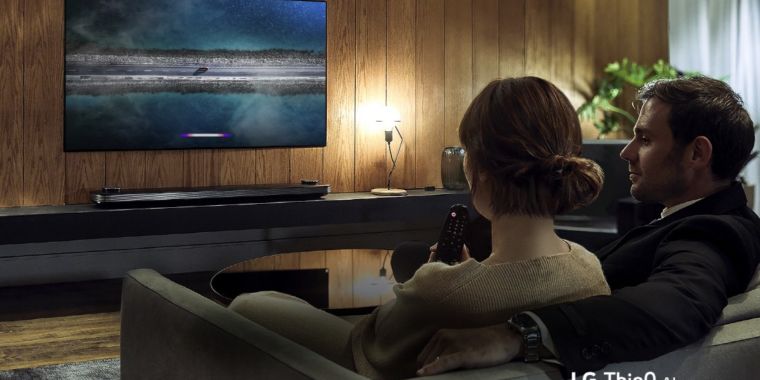
-
As usual, LG included lifestyle marketing images with its press release. Here, a whole galaxy apparently awaits those who install OLED TVs in extremely stark, modernist apartments.
-
You can watch LG TVs with your significant other, it seems. Neat!
-
You can talk to it, because if last year's CES showed us anything, it's that Google Assistant and Amazon Alexa must be in all the things, whether you want them or not.
-
For a moment, we weren't sure whether this was an LG marketing image or a cut-out from a JCPenney catalog.
-
Renders of the OLED lineup.
-
Renders of the LCD lineup.
LG has announced its TV lineup in the lead-up to the 2019 Consumer Electronics Show (CES) next week. As in other recent years, the company has split its lineup between LCD and OLED models, and the OLED models are generally the most interesting. This year, LG's OLEDs and certain high-end LCD TVs will support HDMI 2.1, allowing them to display 4K content at 120Hz over HDMI.
HDMI 2.1 is also relevant for the emerging 8K TV category, as the previous version of HDMI only allowed 8K at 30 frames per second (fps). LG will introduce two 8K TVs—the 88-inch Z9 OLED TV and the 75-inch SM99 LCD TV—that can handle 60Hz content at the full 8K resolution over HDMI. Samsung announced its first mass-market 8K TV in late 2018, and it was limited to 30Hz. Granted, there is virtually no 60Hz 8K content available in most markets, and very little 120Hz 4K content. But that could change as TVs like these come to market.Speaking of HDMI, the sets with HDMI 2.1 will also support eARC (enhanced audio return channel)—an audio-over-HDMI feature that makes many a home theater enthusiast's life a little simpler.
HFR content is also supported by LG's Alpha 9 Gen 2 CPU in the Z9, W9, E9, and C9 OLED models (plus the SM99 and SM8X LCD sets), which LG says uses AI and deep learning "from a vast database of over 1 million visual data" to analyze and enhance the image based on what's going on in the picture and the content type. It's a little similar in some ways to the AI and ML features in smartphone cameras these days. LG claims its silicon solution can help with audio, too. Specifically, the company's press release says the TVs will run algorithms that up-mix 2-channel audio to virtual 5.1 surround sound. Dolby Atmos is also supported.The new B9—LG's entry-level OLED TV—insomuch as that phrase makes sense—will ship with a 2nd-gen Alpha 7 processor, so it will miss out on some of the big features.
LG's OLEDs have become quite popular with gamers who want to get the most out of the Xbox One X or PlayStation 4 Pro consoles, and LG is doubling down on that in 2019. LG told FlatpanelsHD that the TVs will deliver 13ms input lag, which is very low for TVs of this type. Assuming burn-in of UI elements doesn't become an issue, that makes these sets very appealing for gamers.Additionally, the TVs with the Alpha 9 Gen 2 CPU will support variable refresh rates (VRR) and automatic low-latency mode (ALLM). These features were recently added to Xbox One consoles but not the PlayStation 4, PlayStation 4 Pro, or Nintendo Switch.
Beyond what we've shared above, LG's sets offer a pretty standard set of features. The actual OLED panels are unchanged, and the design changes are quite subtle. But the previous panels were already excellent; LG's OLED TVs offer better image quality than LCD competitors by most metrics in all but the brightest viewing environments, thanks in no small part to their absolute black levels.Both Google Assistant and Amazon Alexa will be supported out of the box. The new TVs all support four HDR formats: HDR10, HLG, Dolby Vision, and Advanced HDR. There's no HDR10+ support—direct LG competitor Samsung is the main driver of that format.
Finally, the SM9X and SM8X LCD lineup has been rebranded to NanoCell TV "to better highlight the picture enhancement provided by NanoCell technology (NanoColor), color accuracy in wide viewing angle (NanoAccuracy), and ultra-narrow thin bezel with sleek design (NanoBezel)." That's a lot of gratuitous misuse of the term "nano," but there you have it.
LG has not yet announced pricing or availability, but that information might come during its CES press conference on Monday.
Listing image by LG
https://arstechnica.com/gadgets/2019/01/lg-announces-its-2019-oled-tv-lineup-plus-an-8k-monstrosity/Bagikan Berita Ini















0 Response to "LG's new OLED TVs: true 4K/120Hz, variable refresh rates, HDMI 2.1, more - Ars Technica"
Post a Comment